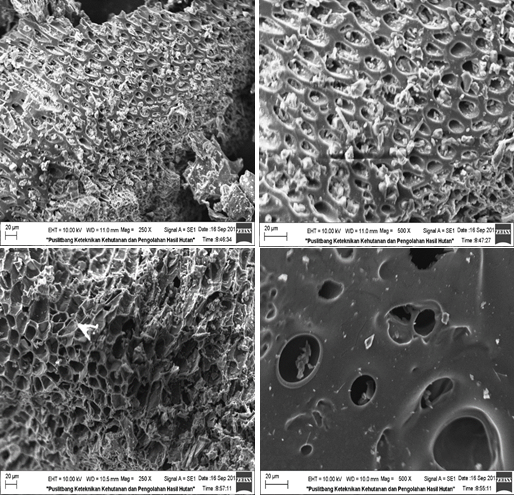
Characterization of activated charcoal microstructure porosity of cashewnut shell (Anacardium occidentale L.)
Abstract
ABSTRACT
Cashew nut (Anacardium occidentale L.) shell is abundantly available as waste from chasew nut processing industries. Cashew nut shell is potentially used for activated charcoal. This paper characterize the porosity microstructure of activated charcoal made from cashew nut shells which is physically activated at various activation temperatures. Initially, cashew nut shells were collected and carbonized at 500°C for 3 hours. Then, the charcoal was activated at 800°C and 1000°C for 60 minutes. The characterization of microstructure porosity of cashew nut shell activated charcoal at transverse cross-section was carried out at 500 times magnification of 10 kV Scanning Electron Microscope (SEM) using a grain-shaped test sample. Observation of the porosity formed on the sample surface included pore size and frequency. Observation data were arranged in tabulated form and analyzed descriptively. The results showed that the frequency of pores in charcoal activated at 1000°C tended to be higher than that of charcoal activated at 800°C. The higher activation temperature increased the pore diameter of the charcoal and decreased the clogging residue.
Keywords: mesoporous, pyrolysis, hydrocarbon
Full Text:
PDFReferences
Alimah, D. (2017). Sifat dan mutu arang aktif dari tempurung biji mete (Anacardium occidentale L.). Jurnal Penelitian Hasil Hutan, 35(2), 123–133. https://doi.org/10.20886/jphh.2017.35.2.123-133
Bonelli, P. R., Della Rocca, P. A., Cerrella, E. G., & Cukierman, A. L. (2001). Effect of pyrolysis temperature on composition, surface properties and thermal degradation rates of Brazil Nut shells. Bioresource Technology, 76(1), 15–22. https://doi.org/10.1016/S0960-8524(00)00085-7
Cai, N., Cheng, H., Jin, H., Liu, H., Zhang, P., & Wang, M. (2020). Porous carbon derived from cashew nut husk biomass waste for high-performance supercapacitors. Journal of Electroanalytical Chemistry, 861, 113933. https://doi.org/10.1016/j.jelechem.2020.113933
Darmawan, S., Syafii, W., Wistara, N. J., Maddu, A., & Pari, G. (2015). Kajian struktur arang-pirolisis, arang-hidro dan karbon aktif dari kayu Acacia mangium Willd. menggunakan difraksi sinar-x. Jurnal Penelitian Hasil Hutan, 33(2), 81–92.
Direktorat Jenderal Perkebunan. (2014). Statistik perkebunan Indonesia : jambu mete 2013-2015. (S. S. Widya Khonik Zuraina, S. K. Eko Pudjianto, S. K. Asep Udin, S. S. Neny Kurniawati, & A. M. Susilo Novianto Damarjati, Eds.). Jakarta: Direktorat Jenderal Perkebunan.
Hastuti, N., Pari, G., Setiawan, D., Mahpudin, & Saepuloh. (2015). Kualitas arang enam jenis kayu asal Jawa Barat sebagai produk destilasi kering. Jurnal Penelitian Hasil Hutan, 33(4), 337–346. https://doi.org/10.20886/jphh.v33i4.934.337-346
Khang, D. S., Hai, T. D., Thi, T. D., & Tuan, P. D. (2020). Dye removal using cashew nut shell activated carbon. Vietnam Journal of Chemistry, 58(6), 832–840. https://doi.org/10.1002/vjch.202000096
Kumar, P. S., Ramalingam, S., & Sathishkumar, K. (2011). Removal of methylene blue dye from aqueous solution by activated carbon prepared from cashew nut shell as a new low-cost adsorbent. Korean Journal of Chemical Engineering, 28(1), 149–155. https://doi.org/10.1007/s11814-010-0342-0
Lempang, M., Syafii, W., & Pari, G. (2011). Struktur dan komponen arang serta arang aktif tempurung kemiri. Jurnal Penelitian Hasil Hutan, 29(3), 278–294. https://doi.org/10.20886/jphh.2011.29.3.278-294
Masthura, M., & Putra, Z. (2018). Karakterisasi mikrostruktur karbon aktif tempurung kelapa dan kayu bakau. Elkawnie, 4(1), 45–54. https://doi.org/10.22373/ekw.v4i1.3076
Mi, J., Wang, X. R., Fan, R. J., Qu, W. H., & Li, W. C. (2012). Coconut-shell-based porous carbons with a tunable micro/mesopore ratio for high-performance supercapacitors. Energy and Fuels, 26(8), 5321–5329. https://doi.org/10.1021/ef3009234
Nagalakshmi, M., & Kalaiselvi, N. (2019). Mesoporous dominant cashewnut sheath derived bio-carbon anode for LIBs and SIBs. Electrochimica Acta, 304, 175–183. https://doi.org/10.1016/j.electacta.2019.02.123
Oliveira, K. F. S. de, Deus Junior, J. O. de, Nascimento, T. L. da S. do, Anjos, R. B. dos, Melo, D. M. de A., Braga, R. M., & Melo, M. A. de F. (2021). Cashew nut shell (Anarcadium accidentale L) charcoal as bioadsorbent to remove Cu2+ and Cr3+. Research, Society and Development, 10(2), e0510212238. https://doi.org/10.33448/rsd-v10i2.12238
Pari, G. (2004). Kajian struktur arang aktif dari serbuk gergaji kayu sebagai adsorben emisi formaldehida kayu lapis [Disertasi Program Doktor]. Institut Pertanian Bogor.
Patel, R. N., Bandyopadhyay, S., & Ganesh, A. (2006). Extraction of cashew (Anacardium occidentale) nut shell liquid using supercritical carbon dioxide. Bioresource Technology, 97(6), 847–853. https://doi.org/10.1016/j.biortech.2005.04.009
Ragupathy, S., Raghu, K., & Prabu, P. (2015). Synthesis and characterization of TiO2 loaded cashew nut shell activated carbon and photocatalytic activity on BG and MB dyes under sunlight radiation. Spectrochimica Acta Part A: Molecular and Biomolecular Spectroscopy, 138, 314–320. https://doi.org/10.1016/j.saa.2014.11.087
Rahmawati, E., & Yuanita, L. (2013). Adsorpsi Pb2+ oleh arang aktif sabut siwalan (Borassus flabellifer). UNESA Journal of Chemistry, 2(3), 82–87.
Salamah, S. (2001). Pembuatan karbon aktif dari tempurung kelapa dengan perlakuan karbonat. In Prosiding Seminar Nasional Kejuangan Teknik Kimia. Yogyakarta.
Santi, D., & Morin, J. V. (2019). Karakterisasi abu kayu merbau (Intsia spp) : pengaruh temperatur dan lama kalsinasi. Jurnal Natural, 15(1), 30–38.
Schröder, E., Thomauske, K., Weber, C., Hornung, A., & Tumiatti, V. (2007). Experiments on the generation of activated carbon from biomass. Journal of Analytical and Applied Pyrolysis, 79, 106–111. https://doi.org/10.1016/j.jaap.2006.10.015
Senthilkumar, P., Ramalingam, S., Abhinaya, R. V., Kirupha, S. D., Vidhyadevi, T., & Sivanesan, S. (2012). Adsorption equilibrium, thermodynamics, kinetics, mechanism and process design of zinc(II) ions onto cashew nut shell. Canadian Journal of Chemical Engineering, 90(4), 973–982. https://doi.org/10.1002/cjce.20588
Widjaja, T., Altway, A., & Soeprijanto. (2009). Studi proses hybrid : adsorpsi pada karbon aktif/membran bioreaktor untuk pengolahan limbah cair industri. In Seminar Nasional Teknik Kimia Indonesia (Vol. 1, pp. 19–20). Bandung.
Yuliana, M., Tran-Thi, N. Y., & Ju, Y. H. (2012). Effect of extraction methods on characteristic and composition of Indonesian cashew nut shell liquid. Industrial Crops and Products, 35(1), 230–236. https://doi.org/10.1016/j.indcrop.2011.07.007
DOI: https://doi.org/10.20886/glm.2021.2.1.16-28
Refbacks
- There are currently no refbacks.
Copyright (c) 2021 Jurnal GALAM

This work is licensed under a Creative Commons Attribution-NonCommercial-ShareAlike 4.0 International License.
Balai Penelitian dan Pengembangan Lingkungan Hidup dan Kehutanan Banjarbaru
Jl. A. Yani Km. 28,7 Guntung Manggis - Landasan Ulin - Banjarbaru Kalimantan Selatan 70721, Kotak Pos 1065, Telp. (0511) 4707872, Fax. (0511) 4707872
e-mail : galamjurnal@gmail.com
Website : http://banjarbaru.litbang.menlhk.go.id/
Jurnal Galam Terindex di :

eISSN 2723-5084, pISSN 2723-4924
Jurnal Galam All content is licensed under a This work is licensed under a Creative Commons Attribution-NonCommercial-ShareAlike 4.0 International License
Copyright © 2020 | Jurnal Galam






